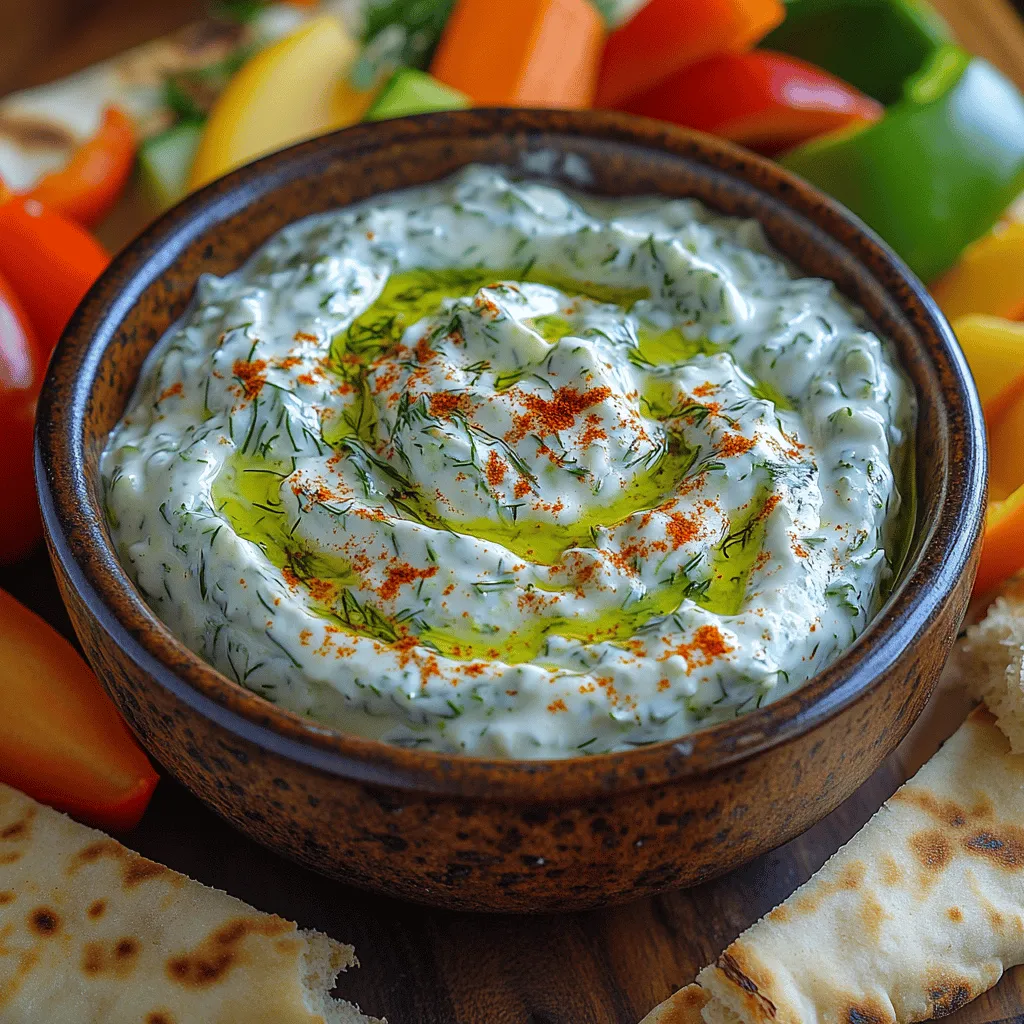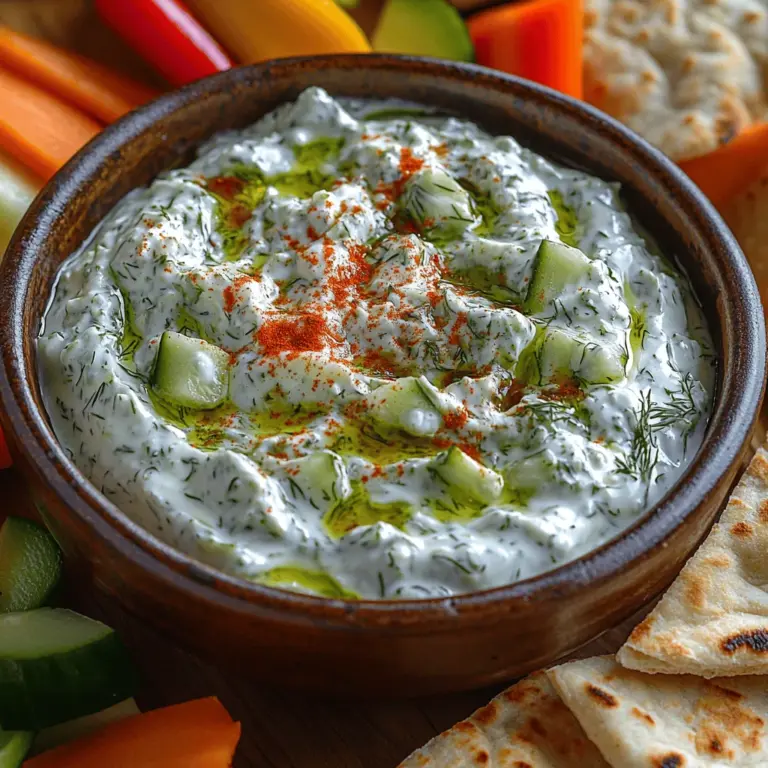Introduction
Tzatziki dip is a beloved staple that hails from the rich and diverse culinary traditions of Mediterranean cuisine. Originating from Greece, this refreshing sauce has made its way into the hearts and kitchens of food lovers around the world. Its creamy texture and zesty flavor profile make it a versatile accompaniment that pairs beautifully with everything from grilled meats and roasted vegetables to pita bread and fresh salads.
One of the key reasons tzatziki has gained such popularity is its ability to refresh and elevate any dish it complements. The combination of creamy Greek yogurt, crisp cucumber, aromatic garlic, and fragrant herbs creates a dip that is both flavorful and satisfying. As a bonus, tzatziki is not only delicious, but it also offers a range of health benefits thanks to its wholesome ingredients.
In this recipe, we will explore the essential components of tzatziki dip and guide you through the simple steps to create this delightful dish right at home. With a focus on fresh, natural ingredients, you can whip up a batch of tzatziki that is both nourishing and indulgent, all while being incredibly easy to prepare.
Understanding the Ingredients
To create the perfect tzatziki dip, understanding the ingredients and their roles is essential. Each component not only contributes to the flavor but also offers various health benefits.
Greek Yogurt
At the heart of tzatziki is Greek yogurt, which serves as the creamy base for this dip. Unlike regular yogurt, Greek yogurt is strained to remove excess whey, resulting in a thicker and creamier texture. This straining process not only enhances the mouthfeel but also concentrates the flavors.
Nutritionally, Greek yogurt is a powerhouse. It is rich in protein, which can help with muscle repair and satiety, making it a great choice for those looking to maintain a balanced diet. Full-fat Greek yogurt is often preferred for tzatziki, as it provides a richer taste and creaminess that enhances the overall flavor of the dip. Additionally, the fat in yogurt can aid in the absorption of fat-soluble vitamins, making it a healthy choice to include in your diet.
Cucumber
The cucumber is another essential ingredient in tzatziki, adding both texture and a refreshing crunch. Cucumbers are high in water content, which helps to keep the dip light and refreshing. This moisture also balances the richness of the yogurt, creating a harmonious blend of flavors.
In terms of nutrition, cucumbers are low in calories yet packed with vitamins and minerals, including vitamin K and potassium. They are also a great source of antioxidants, which can help combat oxidative stress in the body. To ensure the best flavor and texture in your tzatziki, it is crucial to prepare the cucumber properly by removing excess moisture, which can dilute the dip.
Garlic
Garlic is a key ingredient that adds depth and a robust flavor to tzatziki. Known for its pungent aroma and distinct taste, garlic can elevate any dish it graces. Beyond its culinary uses, garlic is celebrated for its numerous health benefits. It contains compounds like allicin, which have been shown to possess anti-inflammatory and immune-boosting properties.
When measuring garlic for tzatziki, consider your personal taste preferences. Some may prefer a milder flavor and use only a clove or two, while others may enjoy a more pronounced garlic presence. Regardless of the amount, garlic is sure to contribute a unique and savory element to your dip.
Olive Oil
A drizzle of high-quality olive oil is a staple in Mediterranean diets and an important addition to tzatziki. Olive oil not only enhances the flavor of the dip but also adds a smoothness that complements the other ingredients. Rich in monounsaturated fats, olive oil is known for its heart-healthy properties and is often associated with reduced inflammation and improved heart health.
When selecting an olive oil for tzatziki, opt for extra virgin olive oil. This type is made from the first pressing of olives and retains the most flavor and nutrients. A good olive oil will add a depth of flavor to your tzatziki that simply cannot be replicated with lower-quality oils.
Vinegar vs. Lemon Juice: Which to Choose?
A common debate among tzatziki enthusiasts is whether to use vinegar or lemon juice in the recipe. Both options can add a tangy brightness to the dip, but they each impart a slightly different flavor profile.
Lemon juice tends to be the preferred choice for tzatziki, as it offers a fresh and zesty taste that complements the other ingredients beautifully. It also adds vitamin C, which can boost the immune system. On the other hand, vinegar—particularly white wine vinegar—can provide a sharper acidity and a more pronounced tang. Ultimately, the choice between vinegar and lemon juice comes down to personal preference and the flavor you wish to achieve.
Dill: Fresh vs. Dried
Dill is the herb that brings a unique flavor to tzatziki, adding an aromatic and slightly sweet note. Fresh dill is often recommended for its vibrant flavor and fragrant aroma, which can elevate the dip to new heights. However, dried dill can be used if fresh is not available, but it is important to note that dried herbs are typically more potent, so you may need to adjust the quantity accordingly.
Using fresh dill not only enhances the flavor but also adds a pop of color, making your tzatziki visually appealing. Dill is also rich in antioxidants and has been associated with digestive health, making it a fantastic addition to this already nourishing dip.
Optional Cayenne Pepper: Adding Heat
For those who enjoy a bit of spice, cayenne pepper can be an optional ingredient in tzatziki. While traditional recipes usually keep the dip mild, a dash of cayenne can introduce a pleasant heat that balances the coolness of the yogurt and cucumber. Cayenne pepper contains capsaicin, which has been shown to have various health benefits, including boosting metabolism and reducing pain.
When adding cayenne, start with a small pinch and adjust according to your spice tolerance. This allows you to customize the heat level of your tzatziki to suit your taste.
Step-by-Step Preparation
Now that we’ve explored the ingredients, let’s dive into the step-by-step preparation of this zesty creamy Greek yogurt tzatziki dip.
Preparing the Cucumber
The first step in making tzatziki is preparing the cucumber. To achieve the best texture and flavor, it is important to remove excess moisture from the cucumber before adding it to the dip.
1. Choose the Right Cucumber: Select a firm cucumber, preferably an English cucumber or Persian cucumber, as they have fewer seeds and a thinner skin, which can enhance the overall flavor of the dip.
2. Wash and Grate: Rinse the cucumber under cold water and pat it dry. Using a box grater or a food processor, grate the cucumber. If you prefer a chunkier texture, you can finely chop it instead.
3. Remove Excess Moisture: Place the grated cucumber in a clean kitchen towel or cheesecloth, and twist it to squeeze out as much moisture as possible. This step is crucial, as excess water can make your tzatziki watery and dilute the flavors. Aim to remove as much moisture as you can to ensure a thick and creamy dip.
Mixing the Base
Once the cucumber is ready, it’s time to mix the base of the tzatziki.
1. Combine Greek Yogurt and Garlic: In a mixing bowl, add your strained Greek yogurt. Finely mince the garlic cloves and add them to the yogurt. Use a fork or a whisk to blend them together until well combined. This ensures that the garlic flavor is evenly distributed throughout the dip.
2. Add Olive Oil: Drizzle in your high-quality extra virgin olive oil and mix it in. This will enhance the creaminess of the yogurt and add a rich flavor to the dip.
3. Incorporate the Cucumber and Herbs: Gently fold the prepared cucumber and chopped fresh dill into the yogurt mixture. Be careful not to overmix, as you want to maintain some texture in the dip.
4. Adjust Seasoning: Finally, season your tzatziki with salt, pepper, and your choice of vinegar or lemon juice. Taste and adjust the seasoning as needed, adding more lemon juice or vinegar for acidity, or additional salt and pepper to enhance the flavors.
With these preliminary steps, you’re well on your way to creating a delicious and refreshing tzatziki dip that will impress your family and friends. The beauty of tzatziki lies in its simplicity, making it a perfect addition to any meal or a delightful snack on its own. Stay tuned for the next part, where we will explore serving suggestions and tips for the best tzatziki experience!

Ensuring Even Distribution of Ingredients
Achieving the perfect consistency and flavor in your Zesty Creamy Greek Yogurt Tzatziki Dip requires meticulous attention to how you mix your ingredients. Once you have prepared all the components—Greek yogurt, grated cucumber, minced garlic, lemon juice, and your chosen herbs—it’s crucial to ensure an even distribution. Begin by placing the Greek yogurt in a large mixing bowl, followed by the cucumber, garlic, and lemon juice.
To achieve a homogeneous mixture, use a spatula or a whisk to blend the ingredients gently but thoroughly. This method allows the flavors to meld beautifully without compromising the texture of the cucumbers. Pay special attention to incorporating the garlic and herbs evenly throughout the dip to avoid any concentrated bites. Tzatziki is all about balance, and even distribution plays a significant role in achieving that.
Seasoning to Taste
Once your ingredients are well combined, it’s time to season your tzatziki dip to taste. Taste-testing is key to perfecting this recipe. Begin with a pinch of salt and freshly cracked black pepper. As you stir the seasoning into the dip, remember that the flavors will develop further while the dip chills, so avoid over-seasoning at this stage.
If you prefer a more pronounced flavor, consider adding a drizzle of olive oil or a splash of red wine vinegar. These can enhance the richness of the dip and add depth to its flavor profile. Always taste after each adjustment—this step will help you create a tzatziki that aligns with your palate.
Balancing Flavors and Personal Preferences
Tzatziki is inherently customizable, and finding the perfect balance of flavors is essential. If you find that the tzatziki is too tangy, a bit more yogurt can help mellow the flavor. Conversely, if you desire a sharper taste, adding more lemon juice or garlic can elevate the dip’s zestiness.
For those who enjoy a hint of sweetness, consider incorporating a small amount of finely chopped fresh mint or dill, as these herbs can add a refreshing element that counterbalances the tartness. Remember, this dip is your creation; don’t hesitate to adjust the flavors according to your preferences.
Chilling for Flavor Development
Once you have achieved the desired flavor balance, it’s time for one of the most crucial steps: chilling the tzatziki dip. Chilling allows the flavors to meld and develop, creating a cohesive and delicious dip. The cool temperature also enhances the refreshing qualities of the ingredients, making it an ideal accompaniment for hot dishes or summer gatherings.
How Chilling Enhances Flavor Profiles
The chilling process allows the yogurt to absorb the flavors of the garlic, cucumber, and herbs, resulting in a dip that tastes better than when it’s freshly mixed. This is particularly important for garlic, which can have a sharp bite when first minced. Chilling softens this sharpness, allowing for a more harmonious flavor profile.
Suggested Chilling Time for Best Results
For the best results, cover your tzatziki dip with plastic wrap or transfer it to an airtight container and refrigerate for at least one hour, though two to three hours is optimal. If time allows, consider making your tzatziki the night before serving; the flavors will deepen, providing an even more delightful taste experience.
Serving Suggestions
Tzatziki dip is incredibly versatile and can be served in numerous ways, making it a favorite at gatherings or as a delightful addition to your meals.
Traditional Pairings with Tzatziki
Tzatziki is classically served with warm pita bread and a variety of fresh vegetables. Arrange a platter with sliced cucumbers, carrots, bell peppers, and cherry tomatoes alongside a bowl of tzatziki for a refreshing appetizer. The crunch of the vegetables contrasts beautifully with the creamy dip, creating a satisfying snacking experience.
Creative Uses for Tzatziki Dip
Beyond being a dip, tzatziki can serve as a sauce for grilled meats, such as chicken, lamb, or beef. Its cooling properties pair exceptionally well with the smokiness of grilled dishes, enhancing the overall dining experience. Simply drizzle or dollop tzatziki over your favorite grilled meats for an extra layer of flavor.
Incorporating tzatziki into salads and sandwiches is another fantastic way to enjoy this dip. Use it as a dressing for a Greek salad or as a spread on wraps and sandwiches. It adds creaminess and a burst of flavor, elevating even the simplest meals.
Serving Presentation Ideas
Presentation can make a significant impact, so consider garnishing your tzatziki dip before serving. A sprinkle of finely chopped dill or mint can add a pop of color and a hint of freshness. You might also drizzle a bit of olive oil on top or place a few cucumber slices around the bowl for an appealing visual touch.
Nutritional Information
When prepared with fresh ingredients, tzatziki is not only delicious but also nutritious.
Breakdown of Calories and Macronutrients per Serving
A typical serving of tzatziki (about 2 tablespoons) contains approximately 30-40 calories, depending on the specific ingredients used. The macronutrient breakdown generally includes:
– Carbohydrates: 2-4 grams
– Protein: 2-3 grams
– Fat: 2-3 grams
These values can vary based on the amount of olive oil or yogurt used.
Health Benefits of Key Ingredients
The primary ingredient, Greek yogurt, is rich in protein and probiotics, promoting gut health and aiding digestion. Cucumbers are low in calories and high in water content, making them an excellent hydrating vegetable. Garlic has numerous health benefits, including boosting the immune system and reducing inflammation.
Comparison with Store-Bought Tzatziki
Homemade tzatziki is often healthier than store-bought versions, which can contain preservatives and excessive sodium. By making your own, you can control the ingredients and customize the flavor, ensuring a fresher and more wholesome product.
Culinary Variations
One of the joys of tzatziki is its flexibility. You can easily experiment with different herbs and spices to create variations that suit your taste.
Exploring Different Herbs and Spices
While traditional tzatziki uses dill or mint, you can explore other herbs such as parsley or basil for a unique twist. Each herb brings its own flavor profile, allowing you to tailor the dip to complement your meals.
Adding Mint or Parsley for a Twist
Adding fresh mint can enhance the refreshing quality of tzatziki, making it even more delightful during summer months. Alternatively, parsley can provide a mild flavor that pairs well with the other ingredients.
Creating a Spicy Tzatziki
For those who enjoy a bit of heat, consider incorporating finely chopped jalapeños or a sprinkle of red pepper flakes into your tzatziki. This adds a spicy kick that can elevate the dip, making it an exciting option for those who like it hot.
Vegan Alternatives
If you’re looking for a vegan version of tzatziki, you can substitute Greek yogurt with plant-based yogurt options such as coconut, almond, or soy yogurt. These alternatives can provide a similar creamy texture while keeping the dish entirely plant-based.
Conclusion
Making your own Zesty Creamy Greek Yogurt Tzatziki Dip is not only rewarding but also allows you to enjoy a fresh and flavorful accompaniment that enhances a variety of dishes. The dip’s versatility makes it suitable for different meals, and it’s easy to adapt with personal twists to suit your palate.
As you experiment with flavors, remember the health benefits of using fresh ingredients and the joy that comes from creating something delicious in your own kitchen. Whether served as a dip, sauce, or spread, tzatziki is sure to impress your family and friends. So, roll up your sleeves, gather your ingredients, and enjoy the process of crafting this delightful dip!


